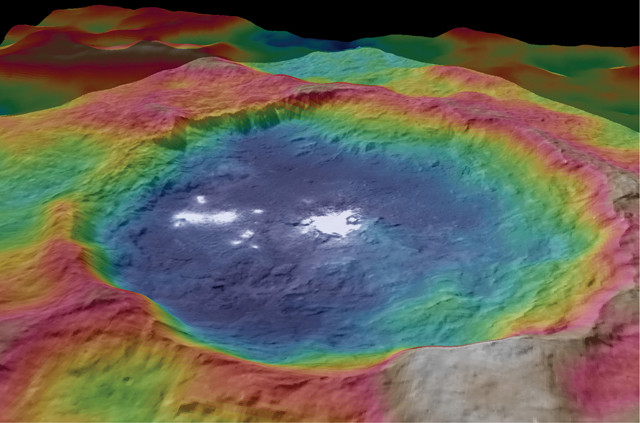
by Harvey Leifert Monday, March 19, 2018

A color-coded topographic map of Occator Crater on Ceres (blue indicates the lowest elevation and brown the highest). The 34-million-year-old crater, approximately 92 kilometers wide and 4 kilometers deep, contains the brightest material on the dwarf planet. Credit: NASA/JPL-Caltech/UCLA/MPS/DLR/IDA.
Orbiting in the asteroid belt between Mars and Jupiter, Ceres is the nearest dwarf planet to Earth and the only one within the inner solar system. It has been studied closely by NASA’s Dawn spacecraft since March 2015.
Now in the second extension of its mission, Dawn has been providing a stream of data, some of which have surprised researchers. In particular, more than 300 bright spots on Ceres’ surface may suggest ongoing geologic activity, said Carol Raymond, manager of the small bodies program at NASA’s Jet Propulsion Laboratory at Caltech. Raymond made the announcement at a press conference on recent Dawn findings at the American Geophysical Union fall meeting in New Orleans last December.
The bright spots are associated with sodium carbonate, a mineral found in hydrothermal deposits on Earth and also in plumes ejected from Saturn’s moon Enceladus, Raymond said. “We now know that this bright material reveals evidence for the past subsurface ocean and geologic processes which have been bringing it to the surface.”
Scientists have focused primarily on Ceres’ 92-kilometer-wide Occator Crater, because in its center it hosts the brightest features, which have been named Cerealia Facula. More diffuse spots nearby are named Vinalia Faculae.
Occator is a relatively young crater, thought to have formed about 34 million years ago, and the bright deposits within it are younger still, at 4 million years old. Detailed surface maps produced during the first extension of Dawn’s mission show that the brightest spots lie in the deepest portion of Occator. Fracture lines on the walls and floor of the crater suggest a plug of subsurface material pushing upward toward the surface. The central bright spot is topped by a dome, which is also marked by recent fractures, she said.
Ceres has bright spots all over its surface, said Nathan Stein of Caltech at the press conference. Although brightness is a relative term, he emphasized. “The brightest spot on the surface actually has an albedo of between 0.4 and 0.5 [similar to ice on Earth]. On average, most [of Ceres’] surface bright spots are closer to 0.08, which is a little bit brighter than charcoal [0.04].”
Most of the bright spots are associated with impact craters, which is not a coincidence, Stein said, and they are geologically young features, ranging in age from several hundred thousand years, or less, to several hundred million years. The bright spots have been assigned to four classes based on associated geologic features. Some, like Cerealia Facula, the brightest, lie on crater floors. Bright spots have been identified on the floors of eight craters. The majority, however, are found on rims or walls of craters, and they usually streak down, sometimes all the way to the crater floor. Another class is found on crater ejecta, and a lone example has been found high on a 4,000- to 5,000-meter-high mountain.
The formation of the bright spots requires the presence of liquid brine, and the young age of some bright spots suggests that liquid brines may exist today in the subsurface. “Ceres isn’t a dead body” as was once assumed, Stein said. “The surface is still dynamic.”
Subsurface brines could have reached the surface and formed the carbonate-rich bright spots via either temperature-induced or impact-induced pressure changes at depth, reported Lynnae Quick, a geologist with the Smithsonian Center for Earth and Planetary Studies and a member of the Dawn science team, at the press conference. The freezing of brine over time could have caused it to expand and reach the surface through fractures. Or the impact that formed Occator could have “squeezed and pinched” the brine reservoirs, also forcing them to the surface via fractures, she said. The brine, she said, could’ve pushed through to the surface by great pressure — shot up like soda from a can that had been shaken and then opened. In the near-zero pressure space above the crater, that “fountaining” subsided and the brine pooled into a domelike shape in the center of the crater.
Mount St. Helens could be an analogue to Occator, Quick said. Since its catastrophic eruption in 1980, it has been rebuilding itself and now has several domes within its remaining crater. These too have been formed by a high-viscosity liquid — lava in this case — being forced to the surface, carrying ash and rock particles instead of Occator’s vapor, salt particles and ice crystals.
Intriguingly, Quick said, processes that took place on Ceres in the past may still be active on outer planet moons, such as Saturn’s Enceladus and Jupiter’s Europa.
During its current mission, Dawn will be diving to a lower elliptical orbit than it previously held, down to an altitude of just 30 kilometers, to obtain more accurate data on surface chemistry and unprecedented high-resolution images of specific features, Raymond said. Unlike some other exploratory spacecraft, Dawn will not crash onto the surface of Ceres when its useful life is over, which could come as early as April 2018. To avoid contaminating the dwarf planet, it will remain in orbit around Ceres permanently.
© 2008-2021. All rights reserved. Any copying, redistribution or retransmission of any of the contents of this service without the expressed written permission of the American Geosciences Institute is expressly prohibited. Click here for all copyright requests.